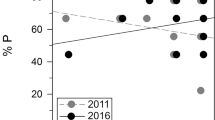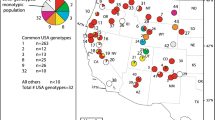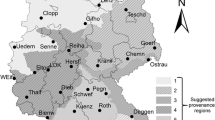Abstract
Knowledge of the pathways of colonization is critical for risk assessment and management of weeds. In this study we adopted a landscape genetics approach to assess the impact of human disturbances and large-scale environmental features on the colonization of a global agricultural weed, Raphanus raphanistrum. We used nuclear microsatellite and chloroplast DNA sequence data to quantify the pattern of genetic diversity in 336 plants collected from 13 sites throughout the Cape Floristic Region, South Africa, one of the world’s recognized global biodiversity hotspots. The lack of strong spatial genetic structure suggests that R. raphanistrum colonized throughout the Cape Floristic Region via both local diffusive spread and long-distance jump dispersal. Furthermore, 47 % of analyzed plants contained Raphanus sativus (cultivated radish) chloroplast genomes, indicating historical and/or contemporary gene flow between wild and cultivated radish populations. The prevalence of high genetic diversity and long-distance gene flow are discussed in the context of ecological risk assessment.



Similar content being viewed by others
References
Albrecht M, Duelli P, Obrist MK, Kleijn D, Schmid B (2009) Effective long-distance pollen dispersal in Centaurea jacea. PLoS ONE 4:e6751
Ammitzbøll H, Bagger Jørgensen R (2006) Hybridization between oilseed rape (Brassica napus) and different populations and species of Raphanus. Environ Biosaf Res 5:3–13
Barnaud A, Deu D, Garine E et al (2009) A weed-crop complex in sorghum: dynamics of genetic diversity in a traditional farming system. Am J Bot 96:1–11
Belkhir K, Borsa P, Chikhi L, Raufaste N, Bonhomme F (1996–2004) GENETIX 4.05, logiciel sous Windows TM pour la génétique des populations. Université de Montpellier II, Montpellier, France
Berthouly-Salazar C, Janse van Rensburg B, Le Roux JJ et al (2012) Spatial sorting drives morphological variation in the invasive bird, Acridotheris tristis. PLoS ONE 7:e38145
Blackburn TM, Pyšek P, Bacher S et al (2011) A proposed unified framework for biological invasions. TREE 26:333–339
Born C, Le Roux PC, Spohr C et al (2012) Plant dispersal in the sub-Antarctic inferred from anisotropic genetic structure. Mol Ecol 21:184–194
Bossdorf O, Auge H, Lafuma L et al (2005) Phenotypic and genetic differentiation between native and introduced plant populations. Oecologia 144:1–11
Campbell LG, Snow AA (2009) Can feral weeds evolve from cultivated radish (Raphanus sativus, Brassicaceae)? Am J Bot 96:498–506
Campbell LG, Snow AA, Ridley CE (2006) Weed evolution after crop gene introgression: greater survival and fecundity of hybrids in a new environment. Ecol Lett 9:1198–1209
Chief Directorate of Surveys and Mapping (c1998) Topographical maps (scale 1:50 000). Chief Directorate: surveys and mapping, Mowbray, South Africa
Clement M, Posada D, Crandall KA (2000) TCS: a computer program to estimate gene genealogies. Mol Ecol 9:1657–1659
Cousens RD, Wiegand T, Taghizadeh MS (2008) Small-scale spatial structure within patterns of seed dispersal. Oecologia 158:437–448
Cox GW (2004) Alien species and evolution: the evolutionary ecology of exotic plants, animals, microbes, and interacting native species. Island Press, Washington, US
Devos Y, De Schrijver A, Reheul D (2009) Quantifying the introgressive hybridisation propensity between transgenic oilseed rape and its wild/weedy relatives. Environ Monit Assess 149:303–322
Eber F, Boucherie R, Broucqsault LM, Boucher Y, Chèvre AM (1998) Spontaneous hybridization between vegetable crops and weeds. 1: garden radish (Raphanus sativus L.) and wild mustard (Sinapis arvensis L.). Agronomie 18:489–497
Ellstrand NC, Schierenbeck KA (2000) Hybridization as a stimulus for the evolution of invasiveness in plants? Proc Natl Acad Sci USA 97:7043–7050
Ellstrand NC, Prentice HC, Hancock JF (1999) Gene flow and introgression from domesticated plants into their wild relatives. Annu Rev Ecol Evol Syst 30:539–563
Excoffier L, Smouse P, Quattro J (1992) Analysis of molecular variance inferred from metric distances among DNA haplotypes: application to human mitochondrial DNA restriction data. Genetics 131:479–491
Excoffier L, Laval G, Schneider S (2005) Arlequin ver. 3.0: an integrated software package for population genetics data analysis. Zoological Institute, University of Berne, Switzerland. Available from URL: http://cmpg.unibe.ch/software/arlequin3/
Frantz AC, Cellina S, Krier A, Schley L, Burke T (2009) Using spatial Bayesian methods to determine the genetic structure of a continuously distributed population: clusters or isolation by distance? J Appl Ecol 46:493–505
Gaertner M, Den Breeyen A, Hui C, Richardson DM (2009) Impacts of alien plant invasions on species richness in Mediterranean-type ecosystems: a meta-analysis. Prog Phys Geogr 33:319–338
Goudet J (2002) FSTAT: a program to estimate and test gene diversities and fixation indices (version 2.9.3.2). Available from URL: http://www2.unil.ch/popgen/softwares/fstat.htm
Gueritaine G, Sester M, Eber F, Chèvre AM, Darmency H (2002) Fitness of backcross six of hybrids between transgenic oilseed rape (Brassica napus) and wild radish (Raphanus raphanistrum). Mol Ecol 11:1419–1426
Guillot G, Estoup A, Mortier F, Cosson JF (2005a) A spatial statistical model for landscape genetics. Genetics 170:1261–1280
Guillot G, Mortier F, Estoup A (2005b) Geneland: a computer package for landscape genetics. Mol Ecol Notes 5:712–715
Hardy OJ, Vekemans X (2002) SPAGeDi: a versatile computer program to analyse spatial genetic structure at the individual or population levels. Mol Ecol Notes 2:618–620
Hashem A, Dhammu HS (2002) Cross-resistance to imidazolinone herbicides in chlorsulfuron-resistant Raphanus raphanistrum. Pest Manag Sci 58:917–919
Hodkinson DJ, Thompson K (1997) Plant dispersal: the role of man. J Appl Ecol 34:1484–1496
Holm LG, Doll J, Holm E, Pancho J, Herberger J (1997) World weeds: natural histories and distributions. John Wiley, New York, USA
Joly S, Stevens MI, Jansen van Vuuren B (2007) Haplotype networks can be misleading in the presence of missing data. Syst Biol 56:857–862
Kalwij JM, Robertson M, Van Rensburg BJ (2008a) Human activity facilitates altitudinal expansion of exotic plants along a road in montane grassland, South Africa. Appl Veg Sci 11:491–498
Kalwij JM, Milton SJ, McGeoch MA (2008b) Road-side verges: corridors for problem plant dispersal: a spatial hierarchical approach. Land Ecol 23:439–451
Lee CE (2002) Evolutionary genetics of invasive species. Trends Ecol Evol 17:386–391
Linder HP (2003) The radiation of the Cape flora, southern Africa. Biol Rev 78:597–638
Lynch SD (2003) The development of a raster database of annual, monthly and daily rainfall for southern Africa. Water Research Commission, Pretoria, South Africa
Mack RN, Lonsdale WM (2001) Humans as global plant dispersers: getting more than we bargained for. Bioscience 51:95–102
Manel S, Schwartz M, Luikart G, Taberlet P (2003) Landscape genetics: combining landscape ecology and population genetics. Trends Ecol Evol 18:89–197
McGeoch MA, Kalwij JM, Rhodes JI (2009) A spatial assessment of Brassica napus gene flow potential to wild and weedy relatives in the Fynbos Biome. S Afr J Sci 105:109–115
Myers N, Mittermeier RA, Mittermeier CG, da Fonseca GAB, Kent J (2000) Biodiversity hotspots for conservation priorities. Nature 403:853–858
Nei M (1978) Estimation of average heterozygosity and genetic distance from a small number of individuals. Genetics 89:583–590
Nei M (1987) Molecular evolutionary genetics. Columbia University Press, New York, US
Posada D, Crandall KA (2001) Intraspecific gene genealogies: trees grafting into networks. Trends Ecol Evol 16:37–45
Pyšek P, Hulme PE (2005) Spatio-temporal dynamics of plant invasions: linking pattern to process. Ecoscience 12:302–315
Quinn GP, Keough MJ (2002) Experimental design and data analysis for biologists. Cambridge University Press, Cambridge, UK
Rambaut A (2002) Se-Al: sequence alignment editor version 2.0a11. Available from URL: http://tree.bio.ed.ac.uk/software/seal/
Raymond M, Rousset F (1995) Genepop (Version 1.2): population genetics software for exact tests and ecumenisms. J Hered 86:248–249
Richardson DM, Pyšek P, Rejmánek M, Barbour MG, Panetta DF, West CJ (2000) Naturalization and invasion of alien plants—concepts and definitions. Div Distrib 6:93–107
Ridley CE, Kim S, Ellstrand NC (2008) Bidirectional history of hybridization in California wild radish, Raphanus sativus (Brassicaceae), as revealed by chloroplast DNA. Am J Bot 95:1437–1442
Rouget M, Richardson DM, Cowling RM, Lloyd JW, Lombard AT (2003) Current patterns of habitat transformation and future threats to biodiversity in terrestrial ecosystems of the Cape Floristic Region, South Africa. Biol Conserv 112:63–85
Sahli HF, Conner JK, Shaw FH, Howe S, Lale A (2008) Adaptive differentiation of quantitative traits in the globally distributed weed, wild radish (Raphanus raphanistrum). Genetics 180:945–955
Sakai AK, Allendorf FW, Holt JS et al (2001) The population biology of invasive species. Annu Rev Ecol Evol Syst 32:305–332
Shaw J, Lickey EB, Schilling EE, Small RL (2007) Comparison of whole chloroplast genome sequences to choose noncoding regions for phylogenetic studies in angiosperms: the tortoise and the hare III. Am J Bot 94:275–288
Smit JJ, Cairns ALP (2001) Resistance of Raphanus raphanistrum to chlorsulfuron in the Republic of South Africa. Weed Res 41:41–47
Storfer A, Murphy MA, Evans JS et al (2007) Putting the ‘landscape’ in landscape genetics. Heredity 98:128–142
Thunberg CP (1807) Flora Capensis: sistens plantas promontorii bonae spei Africes, secundum systema sexuale emendatum redactas ad classes, ordines, genera et species, cum differentiis specificis, synonymis et descriptionibus. Litteris J. F, Edman
USGS (2004) Three arc seconds SRTM elevation data, reprocessed to GeoTIFF. University of Maryland, College Park, Maryland, US
van Oosterhout C, Hutchinson WF, Wills DPM, Shipley P (2004) Micro-Checker: software for identifying and correcting genotyping errors in microsatellite data. Mol Ecol Notes 4:535–538
Vekemans X, Hardy OJ (2004) New insights from fine-scale spatial genetic structure analyses in plant populations. Mol Ecol 13:921–935
Walsh MJ, Duane RD, Powles SB (2001) High frequency of chlorsulfuron-resistant wild radish (Raphanus raphanistrum) populations across the Western Australian Wheatbelt. Weed Tech 15:199–203
Warwick SI, Francis A (2005) The biology of Canadian weeds. 132. Raphanus raphanistrum L. Can J Plant Sci 85:709–733
Werth S, Wagner HH, Gugerli F, Holderegger R, Csencsics D, Kalwij JM, Scheidegger C (2007) Quantifying dispersal and establishment limitation in a population of an epiphytic lichen. Ecology 87:2037–2046
Wilson JR, Dormontt EE, Prentis PJ, Lowe AJ, Richardson DM (2009) Something in the way you move: dispersal pathways affect invasion success. Trends Ecol Evol 24:136–144
Woolcock JL, Cousens R (2000) A mathematical analysis of factors affecting the rate of spread of patches of annual weeds in an arable field. Weed Sci 48:27–34
Acknowledgments
AB was supported through the DST-NRF Centre of Excellence for Invasion Biology, and JMK by the European Union through the European Regional Development Fund (Centre of Excellence FIBIR). We are grateful to S. Bottalico for sampling assistance and to J. Honing for help with DNA extractions. Genotyping was done at Stellenbosch University’s Central Analytical Facility.
Author information
Authors and Affiliations
Corresponding author
Electronic supplementary material
Below is the link to the electronic supplementary material.
Rights and permissions
About this article
Cite this article
Barnaud, A., Kalwij, J.M., McGeoch, M.A. et al. Patterns of weed invasion: evidence from the spatial genetic structure of Raphanus raphanistrum . Biol Invasions 15, 2455–2465 (2013). https://doi.org/10.1007/s10530-013-0465-4
Received:
Accepted:
Published:
Issue Date:
DOI: https://doi.org/10.1007/s10530-013-0465-4




